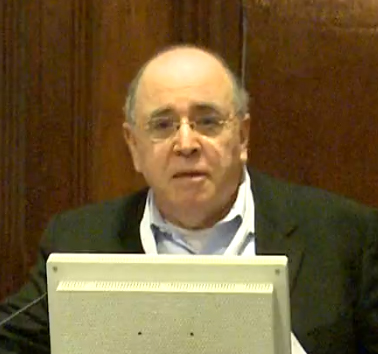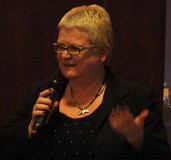Endometriosis Foundation of America
Endometriosis 2013 / Endometriosis & Mind: Psychology of Pain
Arnold Wilson, PhD
Thank you very much. Ever the iconoclast I came with no slides as did Dr. Kesselman. But I am a psychologist on a surgical team. What I do is I interview and evaluate women who are prospective endometriosis surgical patients. It is my responsibility to use my findings in order to help design an overall, individualized plan for each endometriosis patient. I then communicate my interpretation of the findings to the entire surgical team. An individualized plan like this includes the role of personality factors on pre and post surgery issues as well as medical, including medication issues.
My background is both as a university professor of psychology and as well as a clinical psychoanalyst. There is a quiet and not very well known revolution going on in applied science these days. Many investigators have recognized and are taking up some fundamental differences between life studied in a laboratory and life lived on the ground. In psychiatry this movement goes by the name of translational research. Have it moved from the research lab to the clinical intervention. In psychology the same movement is called pragmatics. Clinicians cannot... There is too much lost in double blinded studies and other such "gold standards" that fail to provide frontline clinicians with the tools and information that we direly need.
For the purposes of thinking about pain and the mind in endometriosis with you today I specifically identified this shift as requiring an understanding of processes from "mind to mind". Understand what I mean by that "mind to mind". In other words, to understand relevant processes of a woman with endometriosis in her native context we must insist that the psychological and interactive foundation "mind to mind" for such understanding is at play. It is now not sufficient to settle for abstract conceptualizations, generalizations independent of context, of group trends rather than individual differences. This is what I bring today to the study of pain and endometriosis. To get to the heart of the matter we must investigate: 1) Psychological characteristics of endometrial pain relief. 2) What it means for the pain-wracked woman to be not known even by those most intimate to her and what it means to be non-believed when she speaks. 3) The depression/pain cycle; and 4) Some of the dynamics of a clinician/patient relationship. Let us take these now one at a time.
Number one: Psychological characteristics of endometrial pain relief. Pain medications from my perspective can be a means to a different end than relief from pain. Yes, we know that currently there is an epidemic of prescription pain abuse in this country, and that the endometriosis patient must be wary of becoming dependent on narcotics. Certainly when anyone gets a taste of morphine there will be a wish to revisit those feelings of relief. But this epidemic has actually little or no interest to me as I talk with these women and hear about their pain. I peripherally worry that this is a pattern. What they do with their pain is of much more significance to me.
So, for example, one tenth grade girl would day after day roll around the floor in terrible pain while her mother would stand over her and watch and anxiously repeat over and over again, "I never had any pain with my periods in my life". She was saying she did not understand and was frightened by what she saw going on with her daughter. Here the daughter's pain introduced a back and forth characterized by a failed opportunity for the mother to overcome her caretaking anxiety in the face of her daughter's anguish and for the daughter to feel a generational identification with her distress of what it means to be not believed, nor understood.
We communicate with words. Yet the woman with endometriosis has no words to describe her ordeal. Often she must resort to metaphors. I have found that lurking in the background of every endometrial patient is the idea that of others that she can manage the pain with just a demonstration of willpower. The denial of the significance of her pain is potentially devastating. Experienced as a passive indirect attack on a facet of oneself where the greatest vulnerability resides. Some women are hectored "do this, do that" as if the pain will magically just disappear.
One woman woke up from anesthesia after her first surgery and immediately asked her surgeon if he had indeed found endometriosis. He replied yes, holding her hand and she broke down in tears of relief because it was more important to her finally to know that she would be believed than it was to have tracked down after years of misdiagnosis the source of her pain. At the same time the pain of endometriosis knows no parallel. Some like to compare its long term effects to the suffering of traumatic stress disorder. But this comparison is invalid. Traumatic stress disorder is a diagnosis normed on many in combat and survivors of various catastrophes and natural disasters. By contrast, in endometriosis the assault on a woman's body is often rendered invisibly, relentlessly and it is unending on those parts of her body most precious because they are tied up with potential experiences of pleasure and reproduction.
What an awesome phenomena, pelvic pain forever. It is like a nightmarish science fiction story. Almost every woman I have spoken to has voiced this fear that the pain will never go away. It is so tempting to respond with the emptiness and the hollowness of false reassurance. To say, "Don't worry, of course it will go away". But this does not help. In some part because it disregards the piece of this fear that is based on sound reality testing, i.e. that yet may be the case.
The problem of pain is personality pathology will only be made worse when the DSM 5 comes out in May 2013 this year and takes effect. For those of you who do not know this the new nomenclature in its creeping enthusiasm for making all of life's challenges pathological, it brings medical illness into the realm of psychiatric disorders. Pathologizing something in this way, and giving it a name, offers at best the illusion that we understand it. Much better that endometrial distress should stand alone and be defined by its own characteristics.
And what does it mean for the pain-wracked woman to be not known even by those most intimate to her. I saw one young woman who was in severe pain all the time, not just before her period or when ovulating. She was engaged to be married. She faked pleasure in sex. Remarkably, her fiancé had never been told by her of her pain, nor did he suspect anything. She completely hid her pain from him. She told me that if he knew then he might leave her and that would be the final straw in her demise. The woman with endometrial pain after a while can learn not to be forthcoming with these kinds of concerns. This particular person was consumed by the wish to escape into the country, to leave the city. There she could live in isolation that almost, as she spoke, seem to me to approximate a kind of a fugue stick in which nothing would feel quite real but then, and only then, perhaps her fiancé would not leave her.
Another young woman referred to herself repeatedly as an alien. She was serious. She was identified in her distress as one of the possessed characters from the horror movie, the Alien, in which a woman grows monsters inside her pelvic region, which would burst out and attack anything normal.
The depression pain cycle: The woman with endometrial pain faces a cyclical dilemma. Depression makes pain worse. Then, pain makes depression worse. Let us try to untangle this and see what we can do to see it a little bit more clearly. Typically of course, antidepressants and narcotics are used to interrupt this escalating cycle. The number of women with endometriosis on SSRI antidepressants is remarkably high. The reason seems clear enough. Interrupt depression and perhaps some pain will likewise abate or numb the pain and provide vacation for a couple of hours. Cymbalta, by all accounts a favorite judging by how psychopharmacologists vote with their..., works at least in theory by reducing both. However, this is an example of a lab finding that requires a deeper...when applied to actual life. What complicates this and other treatments for the pain/depression cycle is something I have noticed in many of the women I have spoken to. That is, they have reached the end of a kind of a tolerance of depression and pain. Abruptly their entire world morphs into a small and grey place where emotions cannot be felt very strongly. It is like an all embracing cocoon, which the external world cannot reach and through which in turn the woman cannot reach out to the external world. Senses deaden, the mind slows down, the balance between internal and external becomes amorphous. It is a kind of a shut down, a retreat to an isolation that is designed to be protective. Trust is destroyed because it opens possibilities, which must be protected against.
Women use metaphors like "zone" or "new place" to describe the end result to this transition. One of the remarkable things is that almost every woman can describe with pinpoint accuracy the day, the moment, they passed on into this state of mind. I have learned to view it as a subtle psychological piece of the ongoing disease process. What amazes me is how many women, as soon as I mention it, immediately know what I am talking about when I raise this transition with them. Further, once prompted, they can identify the time, the place and the rationale for this shift. It dominates their lives. Once it is recognized many things can swim into focus for them.
What I then realized is that rather than try...the woman with endometrial pain out instead I had to enter into that zone and convey my familiarity with its urgency. A striking example of this took place when I spoke with a couple, a woman with endometriosis and a magnificently supportive and empathic husband. Our conversation began in a desultory fashion. They were resigned to meeting another in a long series of doctors. They had been through this before and were merely navigating the necessary protocol. Dutifully, they both took turns describing to me her history of horrible pain and depression. It also featured medical misdiagnosis that they claimed destroyed any trust they might have in those who might have helped. What I did was I pushed my way into their rage and their resignation. The husband looked at his wife and in an incredulous voice asked, "Does he get it"? I can be quite persistent and I continue to press ahead with my appreciation of her "zone". It became clear to me that the husband had learned how to co-exist in that zone with his wife. At that point the husband said to his wife, "At least I'm allowed to think, I'm almost excited to...voice he does get it. He's come to the other side". I think that also was a Star Wars reference wasn't it?
It was at this point that the atmosphere in the room abruptly changed. For a short time the wife had stepped out of that protective cocoon and was naked with her pain, depression and despair. Her husband followed her. We could really talk. It was difficult, very difficult for me to watch them leave at the end of our assigned time knowing fully well that she was going to return to that withdrawn, terrible place inside her.
We must also take notice of one other aspect of the depression/pain cycle and that is it can seek to reproduce itself and...for a variety of reasons. Please be clear now that I am speaking here of automatic mental processes operating outside of awareness. Depression is inherently masochistic but that is a discussion for another day. For now I merely want to note that its persistence stubbornly defies a rationale understanding. Pain fuels a compulsion to repeat. Here now I am speaking of the linkage of emotional and physical pain. One such reason can be because of unconscious guilt. Another can be the anxiety of allowing something or someone else to hurt you. Rather than see that power it becomes preferable to do it to yourself first and thereby possess omnipotent control over the induction of pain. I have encountered both of these on more than one occasion. But far and away the most frequent reason I have found for the reproduction of pain is because a woman has been hurt so many times and so often that she cannot allow herself to catch the disease of optimism. Another disappointment is too much to bear. It is here that resides one of the most paradoxical and perplexing aspects of the sufferer in endometriosis and that is it can be extremely taxing to get better, to have no pain. A woman in this kind of pain can block everything else out, can live in a narrowed frame where time does not pass or even exist. But the pot of gold at the end of the rainbow cannot be hollow or empty for psychological growth to occur. When the pain is gone the conflicts of everyday life can strike with a vengeance. The magnitude of the losses incurred during the period of active endometriosis has to be fixed and accounted for. I strongly believe that psychological assistance is just as necessary if and when the disease process is arrested as it is when the disease process is active.
The dynamics of a clinician/patient relationship: Endometriosis presents the clinician with a unique set of challengers. Here I speak of all clinicians; physician, psychologist, physical therapist, nurses and so on entrusted with challenges and responsibilities of treating women with endometriosis. I have joked with my esteemed friend, Dr. Seckin, over lunch that perhaps all individuals treating endometriosis should have a mandatory period of personal analysis. I hope the organizing committee will not fire me immediately for my impudence. But my intent in joking this way is rather transparent. In becoming a psychoanalyst myself I underwent my own required analysis in order to be properly equipped to optimally recognize and treat a wide variety of mental states. We work with challenges just as stark. A woman with endometriosis should never be managed. She must first and foremost be understood in her own language and on her own terms, a far more difficult task. It is one that requires skills of a clinician that can be learned and nurtured.
Indeed, the terrible endometrial pain of a young woman pulls for powerful and complex reactions from a clinician. We are trained in bedside manners not to let illness personally distress us as best we can. But clinicians themselves cannot escape a brute fact; and that is that everybody unconsciously seeks to repeat and at the same time undo our own emotional, if not physical, pain.
Every time I talk to a woman with endometriosis I am unconsciously talking to my daughter Julia and trying to somehow protect her. It cannot be otherwise. The propriety of bedside manners can at best cloak this state of affairs.
I am now going to finish up with a very brief conclusion. In conclusion, the tools for treating endometrial pain are in our hands. However, while we fuss about the time honored triumvirate of attack, timing and dosage of what we can do for the provisional relief of pain it is other factors that unleash the therapeutic potential of our ministrations. The choice is really more than between opiates, physical therapy, yoga, exercise, meditation. Every item that we have in our tool box for relieving pain is enhanced by our grasp of the psychological complexities our women patients confront and endure.
I thank you.










